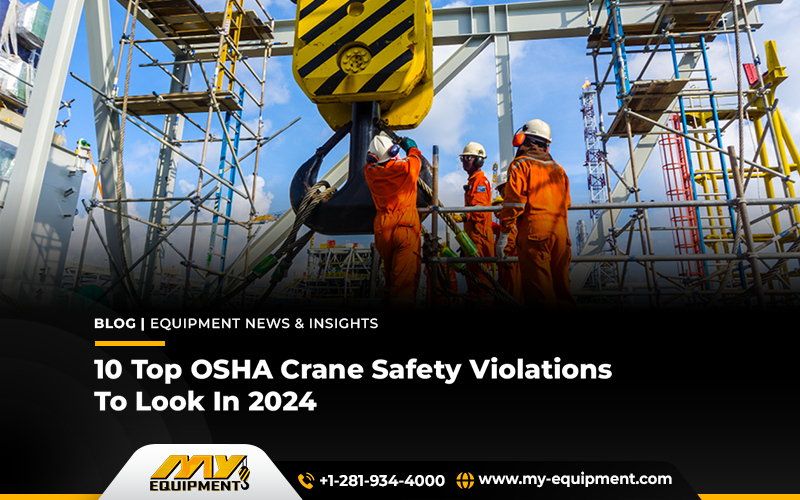Owning a construction crane is not as easy as it may appear. Not only do you spend a hefty fortune in buying the equipment but keeping up with the compliance is also a must.
You need to follow state-level safety regulations to fall under the category of trusted contractors.
Not only do these complaints make you a confident contractor but it also elevates your position in the eyes of clients and investors.
So what are the OSHS crane usage safety compliances that you must follow? Continue reading and explore it all by yourself;
The Role Of Crane Safety On Construction Site
Construction cranes come under the category of heavy machinery which can lead to severe fatalities if not used properly.
The construction cranes for sale require extra attention in terms of regulating their performance for better compliance.
To induce onsite crane usage safety first you need to know the significance of integrating crane safety.
Mentioned below are the top factors why you shouldn’t compromise on the safety consumption of cranes;
- Minimzaton of construction site hazards
- Reduction of uncertain fatalities
- Increment in equipment’s efficiency rate
- Reduction of equipment maintenance and operation expenses
- Prevention of litigation
OSHA Crane Safety Violations To Follow
Knowing the new OSHA guidelines can help you maintain and attain safety certifications to stand tall as a contractor.
Safety compliance will aid in increasing the equipment’s lifespan, creating a secure workplace, and increasing the worth of cranes for sale if you decide to sell the used equipment.
Mentioned below are the top 10 regulations that you must agree to in the coming year;
Fall Prevention
Cranes are heavy-lifting machinery. To operate a crane a worker has to climb high to reach the cabin and if not done right, it can result in falls.
If the operator isn’t wearing personal protection equipment and the terrain is soft it can create serious injury.
According to OSHA all operations that require employees to reach above 6 feet must provide apt training.
Inspections
OSHA obliges all crane operators to conduct a prior inspection session before starting the actual operation.
Through routine inspections, crane operators will be aware of the internal and external components.
This awareness will help them from using the machine beyond its load-lifting capacity.
Single Person Competency
When you get cranes for sale you also need to invest in hiring expert operators and a single person.
Since contraction operations involve heavy machinery along with air pollution, noise pollution is also very common on the site.
A single person shows hand signs or radio signals to guide the crane operator about the surroundings.
OSHA demands a single person have appropriate competency through written, oral, and practical evaluations
Power Line Security
Power lines are dangerous and can put the lives of laborers at risk along with harming the equipment.
It is advised that all crane operators must maintain an appropriate distance from power lines when navigating the equipment.
Clearing Off The Load Zone
Only certain operators are allowed to stand near the fall zone to ensure effective transference of load onto the crane.
All the other laborers must stand very far from the load-shifting zones to avoid any fatality.
Assembling/Dismantling
According to OSHA, if any worker with no prior experience in crane dismantling and rearranging is found doing so, he will be charged with penalties.
Driver’s Certifications
To make sure everyone around the surroundings is safe, OSHA obliges all crane operators to acquire certifications and requests organizations to check before hiring them.
Lockout
Lockouts are to prevent operators from sudden energy release from the equipment during the time of starting.
If the operators fail to ensure in establishment of lockouts they can fall prey to;
- Burns
- Cuts
- Fractures
- Crushing
- Electrocution
- Amputations
- Lacerations
Respiratory Problem Prevention
Due to high-intensity work at construction sites, airborne contaminants reach to a dangerous limit if inhaled by the operator.
It’s a must for all the site engineers to ensure that all the operators are equipped with personal protective equipment like masks and respirators to avoid respiratory issues.
PPE occupation prevents respiratory issues.
Training
Cranes operators must receive training on the safe operation of equipment, power line safety, signaling, emergency procedures, and more.
Takeaway
Construction cranes come under the category of heavy equipment which makes them hard to operate.
On the other side, an unqualified operator can put his and the lives of other people at risk.
For that reason, OSHA as a safety complaint institution adheres to contractors and operators to prevent violations of the above-mentioned standards.


 1400 Broadfield Blvd, Houston, TX 77084,
USA.
1400 Broadfield Blvd, Houston, TX 77084,
USA.